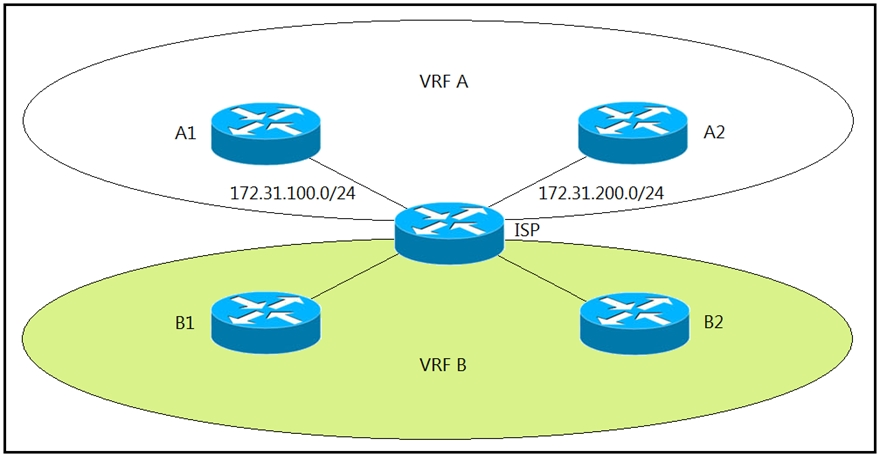
Refer to the exhibit. The ISP router is fully configured for customer A and customer B using the VRF-Lite feature.
What is the minimum configuration required for customer A to communicate between routers A1 and A2?

Refer to the exhibit. The ISP router is fully configured for customer A and customer B using the VRF-Lite feature.
What is the minimum configuration required for customer A to communicate between routers A1 and A2?
The minimum configuration required for customer A to communicate between routers A1 and A2 involves configuring the interfaces and OSPF on the customer routers without the need for VRF configurations, as the ISP router is already fully configured with VRF-Lite. Therefore, setting the appropriate IP addresses on the interfaces and enabling OSPF on those networks will suffice. The configuration option A correctly adheres to this by setting IP addresses and OSPF configurations on routers A1 and A2 without involving VRF commands.
Correct answer is A. Please note that A1, A2, B1 and B2 are Customer routers, therefore they have no idea of VRF.
i agree with A, since A1 and A2 are CE they dont need vrf config, its only necesary in Pe, in this case in ISP router
C. A1 interface fa0/0 description To->ISP ip vrf forwarding A ip add 172.31.100.1 255.255.255.0 no shut ! router ospf 100 net 172.31.100.1 0.0.0.255 area 0 A2 interface fa0/0 description To->ISP ip vrf forwarding A ip add 172.31.200.1 255.255.255.0 no shut ! router ospf 100 net 172.31.200.1 0.0.0.255 area 0 D. A1 interface fa0/0 description To->ISP ip add 172.31.200.1 255.255.255.0 no shut ! router ospf 100 net 172.31.200.1 0.0.0.255 area 0 A2 interface fa0/0 description To->ISP ip add 172.31.100.1 255.255.255.0 no shut ! router ospf 100 net 172.31.100.1 0.0.0.255 area 0
A1 and A2 are CE, no VRFs there.
Answer "A", because we need to perform the configuration on the customer edges, and not on the ISP.
The sentence is not really clear. After reading the question to fast, I though it was the other way around...
Its A: A1 interface fa0/0 description To->ISP ip add 172.31.100.1 255.255.255.0 no shut ! router ospf 100 net 172.31.100.1 0.0.0.255 area 0 A2 interface fa0/0 description To->ISP ip add 172.31.200.1 255.255.255.0 no shut ! router ospf 100 net 172.31.200.1 0.0.0.255 area 0
This is the only config which would work A1 interface fa0/0 description To->ISP ip vrf forwarding A ip add 172.31.100.1 255.255.255.0 no shut ! router ospf 100 net 172.31.100.1 0.0.0.255 area 0 A2 interface fa0/0 description To->ISP ip vrf forwarding A ip add 172.31.200.1 255.255.255.0 no shut ! router ospf 100 net 172.31.200.1 0.0.0.255 area 0
I could be looking at this incorrectly, but if the ISP is fully configured with the proper VRFs on the interfaces connected to A1 and A2, no ip vrf forwarding command is necessary on A1 or A2. All they need is the right IP and Router OSPF with matching areas. With that being said, choice A works with the least amount of effort.
VRF on customer rotuers have not any sense if vrf is fully configured on ISP. this is the real use case scenario of VRF. isolate customers routing tables. Lab scenario A and you will notice.
It’s clearly that A is correct answer, after assign vrf you setup ospf for routing in the vrf.
The question stated the they need too make use of the VRF lite Feature what implies that VRF Forwarding needs too be used. There is also a type error in the answers See : https://itexamanswers.net/question/refer-to-the-exhibit-the-isp-router-is-fully-configured-for-customer-a-and-customer-b-using-the-vrf-lite-feature-what-is-the-minimum-configuration-required-for-customer-a-to-communicate-between-rout
What the question says on ISP vrf is fully configured. that means customer routers are not aware and have not to configue any vrf for this scenario to work.
The question stated the they need too make use of the VRF lite Feature what implies that VRF Forwarding needs too be used. There is also a type error in the answers See : https://itexamanswers.net/question/refer-to-the-exhibit-the-isp-router-is-fully-configured-for-customer-a-and-customer-b-using-the-vrf-lite-feature-what-is-the-minimum-configuration-required-for-customer-a-to-communicate-between-rout
Hello. The question clearly mentions that "The ISP router is FULLY CONFIGURED ... " , not the customer routers... Therefore, the correct answer is A because it doesn't contain any VRF info ( Customers are unaware of the VRF concept ) , and it has the correct IPs. Other than that, all the "vrf-related" answers are incorrect, because they don't mention anywhere the VRF-related creation commands .
A is the correct answer. Firstly, VRF is not configured on the client side that is already completed on the ISP router. Secondly, in the available answers none mentioned the creation of the VRF.
A is correct, the ISP configures the VRF-lite not the customer
As the stament says VRF is fully configured on ISP, customerr routers just have to do is the necesary routing to communicate each other.
Answer B and C are very similar but answer B has wrong IP address on router A2, answer C has the correct configuration for VRF lite to work.
A Explanation A1 and A2 routers do not know they belong to VRF A. The two interfaces of ISP (which are connected to A1 & A2) should be configured like this (we only show the configure of one interface): ISP router: interface g0/0 description ISP->To_CustomerA ip vrf forwarding A ip address 172.31.100.2 255.255.255.0 router ospf 100 vrf A network 172.31.200.2 0.0.0.255 area 0
A is correct